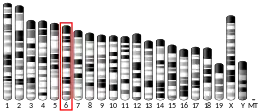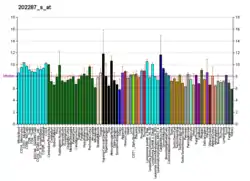Tumor-associated calcium signal transducer 2, also known as Trop-2 and as epithelial glycoprotein-1 antigen (EGP-1),[5] is a protein that in humans is encoded by the TACSTD2 gene.[6][7][8]
This intronless gene encodes a carcinoma-associated antigen defined by the monoclonal antibody GA733. This antigen is a member of a family including at least two type I membrane proteins. It transduces an intracellular calcium signal and acts as a cell surface receptor.
Mutations of this gene result in gelatinous drop-like corneal dystrophy, an autosomal recessive disorder characterized by severe corneal amyloidosis leading to blindness.[8]
Trop-2 expression was originally described in trophoblasts (placenta) and fetal tissues (e.g., lung). Later, its expression was also described in the normal stratified squamous epithelium of the skin, uterine cervix, esophagus, and tonsillar crypts.[9]
Trop-2 plays a role in tumor progression by actively interacting with several key molecular signaling pathways traditionally associated with cancer development and progression. Aberrant overexpression of Trop-2 has been described in several solid cancers, such as colorectal, renal, lung, and breast cancers. Trop-2 expression has also been described in some rare and aggressive malignancies, e.g., salivary duct, anaplastic thyroid, uterine/ovarian, and neuroendocrine prostate cancers.[9]
This antigen is the target of sacituzumab govitecan, an antibody-drug conjugate.
References
- 1 2 3 GRCh38: Ensembl release 89: ENSG00000184292 - Ensembl, May 2017
- 1 2 3 GRCm38: Ensembl release 89: ENSMUSG00000051397 - Ensembl, May 2017
- ↑ "Human PubMed Reference:". National Center for Biotechnology Information, U.S. National Library of Medicine.
- ↑ "Mouse PubMed Reference:". National Center for Biotechnology Information, U.S. National Library of Medicine.
- ↑ Immunomedics Awarded Fast Track Designation by FDA for Sacituzumab Govitecan (IMMU-132) for Triple-Negative Breast Cancer Therapy
- ↑ Linnenbach AJ, Seng BA, Wu S, Robbins S, Scollon M, Pyrc JJ, et al. (March 1993). "Retroposition in a family of carcinoma-associated antigen genes". Molecular and Cellular Biology. 13 (3): 1507–1515. doi:10.1128/MCB.13.3.1507. PMC 359462. PMID 8382772.
- ↑ Calabrese G, Crescenzi C, Morizio E, Palka G, Guerra E, Alberti S (Apr 2001). "Assignment of TACSTD1 (alias TROP1, M4S1) to human chromosome 2p21 and refinement of mapping of TACSTD2 (alias TROP2, M1S1) to human chromosome 1p32 by in situ hybridization". Cytogenetics and Cell Genetics. 92 (1–2): 164–165. doi:10.1159/000056891. PMID 11306819. S2CID 9708614.
- 1 2 "Entrez Gene: TACSTD2 tumor-associated calcium signal transducer 2".
- 1 2 Vranic S, Gatalica Z (February 2022). "Trop-2 protein as a therapeutic target: A focused review on Trop-2-based antibody-drug conjugates and their predictive biomarkers". Bosnian Journal of Basic Medical Sciences. 22 (1): 14–21. doi:10.17305/bjbms.2021.6100. PMC 8860310. PMID 34181512.
Further reading
- Linnenbach AJ, Wojcierowski J, Wu SA, Pyrc JJ, Ross AH, Dietzschold B, et al. (January 1989). "Sequence investigation of the major gastrointestinal tumor-associated antigen gene family, GA733". Proceedings of the National Academy of Sciences of the United States of America. 86 (1): 27–31. Bibcode:1989PNAS...86...27L. doi:10.1073/pnas.86.1.27. PMC 286396. PMID 2911574.
- Fornaro M, Dell'Arciprete R, Stella M, Bucci C, Nutini M, Capri MG, Alberti S (September 1995). "Cloning of the gene encoding Trop-2, a cell-surface glycoprotein expressed by human carcinomas". International Journal of Cancer. 62 (5): 610–618. doi:10.1002/ijc.2910620520. PMID 7665234. S2CID 23260113.
- El Sewedy T, Fornaro M, Alberti S (January 1998). "Cloning of the murine TROP2 gene: conservation of a PIP2-binding sequence in the cytoplasmic domain of TROP-2". International Journal of Cancer. 75 (2): 324–330. doi:10.1002/(SICI)1097-0215(19980119)75:2<324::AID-IJC24>3.0.CO;2-B. PMID 9462726.
- Ripani E, Sacchetti A, Corda D, Alberti S (May 1998). "Human Trop-2 is a tumor-associated calcium signal transducer". International Journal of Cancer. 76 (5): 671–676. doi:10.1002/(SICI)1097-0215(19980529)76:5<671::AID-IJC10>3.0.CO;2-7. PMID 9610724.
- Tsujikawa M, Kurahashi H, Tanaka T, Nishida K, Shimomura Y, Tano Y, Nakamura Y (April 1999). "Identification of the gene responsible for gelatinous drop-like corneal dystrophy". Nature Genetics. 21 (4): 420–423. doi:10.1038/7759. PMID 10192395. S2CID 2275476.
- Nakamura T, Nishida K, Dota A, Adachi W, Yamamoto S, Maeda N, et al. (May 2000). "Gelatino-lattice corneal dystrophy: clinical features and mutational analysis". American Journal of Ophthalmology. 129 (5): 665–666. doi:10.1016/S0002-9394(00)00369-X. PMID 10844062.
- Kinoshita S, Nishida K, Dota A, Inatomi T, Koizumi N, Elliott A, et al. (July 2000). "Epithelial barrier function and ultrastructure of gelatinous drop-like corneal dystrophy". Cornea. 19 (4): 551–555. doi:10.1097/00003226-200007000-00029. PMID 10928776. S2CID 43011710.
- Tsujikawa M, Tsujikawa K, Maeda N, Watanabe H, Inoue Y, Mashima Y, et al. (August 2000). "Rapid detection of M1S1 mutations by the protein truncation test". Investigative Ophthalmology & Visual Science. 41 (9): 2466–2468. PMID 10937555.
- Ha NT, Fujiki K, Hotta Y, Nakayasu K, Kanai A (July 2000). "Q118X mutation of M1S1 gene caused gelatinous drop-like corneal dystrophy: the P501T of BIGH3 gene found in a family with gelatinous drop-like corneal dystrophy". American Journal of Ophthalmology. 130 (1): 119–120. doi:10.1016/S0002-9394(00)00596-1. PMID 11004271.
- Tasa G, Kals J, Muru K, Juronen E, Piirsoo A, Veromann S, et al. (November 2001). "A novel mutation in the M1S1 gene responsible for gelatinous droplike corneal dystrophy". Investigative Ophthalmology & Visual Science. 42 (12): 2762–2764. PMID 11687514.
- Yoshida S, Kumano Y, Yoshida A, Numa S, Yabe N, Hisatomi T, et al. (June 2002). "Two brothers with gelatinous drop-like dystrophy at different stages of the disease: role of mutational analysis". American Journal of Ophthalmology. 133 (6): 830–832. doi:10.1016/S0002-9394(02)01407-1. PMID 12036680.
- Ren Z, Lin PY, Klintworth GK, Iwata F, Munier FL, Schorderet DF, et al. (June 2002). "Allelic and locus heterogeneity in autosomal recessive gelatinous drop-like corneal dystrophy". Human Genetics. 110 (6): 568–577. doi:10.1007/s00439-002-0729-z. PMID 12107443. S2CID 24052349.
- Ha NT, Chau HM, Cung LE, Thanh TK, Fujiki K, Murakami A, Kanai A (March 2003). "A novel mutation of M1S1 gene found in a Vietnamese patient with gelatinous droplike corneal dystrophy". American Journal of Ophthalmology. 135 (3): 390–393. doi:10.1016/S0002-9394(02)01952-9. PMID 12614764.
- Gires O, Eskofier S, Lang S, Zeidler R, Münz M (2003). "Cloning and characterisation of a 1.1 kb fragment of the carcinoma-associated epithelial cell adhesion molecule promoter". Anticancer Research. 23 (4): 3255–3261. PMID 12926061.
- Tian X, Fujiki K, Li Q, Murakami A, Xie P, Kanai A, et al. (March 2004). "Compound heterozygous mutations of M1S1 gene in gelatinous droplike corneal dystrophy". American Journal of Ophthalmology. 137 (3): 567–569. doi:10.1016/j.ajo.2003.08.008. PMID 15013888.
- Murakami A, Kimura S, Fujiki K, Fujimaki T, Kanai A (2004). "Mutations in the membrane component, chromosome 1, surface marker 1 (M1S1) gene in gelatinous drop-like corneal dystrophy". Japanese Journal of Ophthalmology. 48 (4): 317–320. doi:10.1007/s10384-003-0064-5. PMID 15295654. S2CID 28358081.






